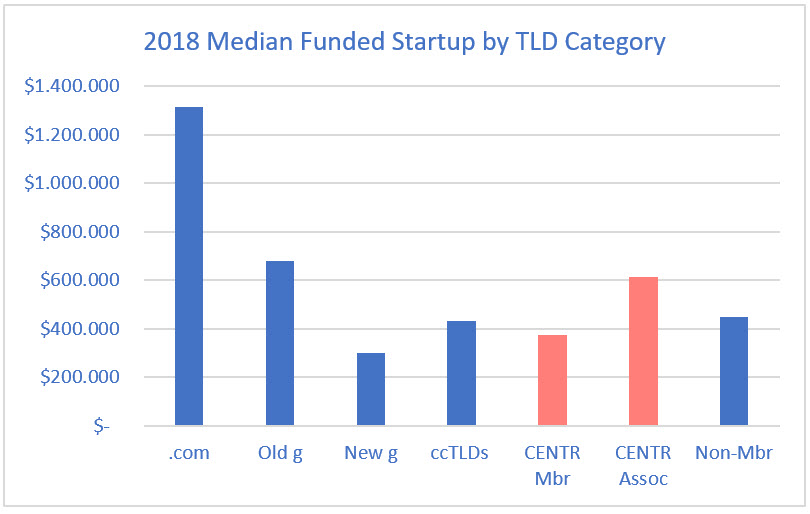People are looking for real numbers regarding domain names so here they are! This is proof based on real business numbers.
Do you want more funding for your startup? Get a .com domain name! Simple as that!
John Matson and CENTR did an analysis based on data from www.crunchbase.com: ccTLD Choice for Startup Businesses: 2018 vs 2017 Analysis.
They analyzed domain name and their startup funding that included angel, seed, grant, crowd, private equity, debt, secondary market, initial coin offering, venture capital, post-IPO and corporate funding.
Startup Funding and TLD Market Share: Setting the Stage
In 2018, over $453B of startup to later stage company funding1 was committed to 22,934 companies with domain names in countries around the globe. CENTR asked: “What are the different ccTLD and gTLD market shares by number of startups and funding” and “will there be a substantial difference in TLD choice by total domain market share for a country versus startup businesses market share?”
At the end of 2018 there were 348M domain names comprised by 45% ccTLDs and 55% gTLDs, with .com having the dominant market share of 39% for a single TLD. Transitioning to the count of startups, the ccTLD market share decreased to 23% (5,379 startups). The funding market share of ccTLDs further reduced to 13% ($58B).
The drop in total domain market share from 45% to 23% likely reflects that startups may have greater global aspirations, resulting in a higher market share of .com choice.
Since 2016, startups with a domain name increased from 16,200 to 22,943; that is an increase of 41% over that period, or 18% in 2016-17 and 19% in 2017-18. However, during that same time, the market share across the categories of TLDs (.com, legacy gTLDs, new gTLDs and ccTLDs) remained fairly constant from year to year. ccTLDs comprised 23-24% of the startup companies each year and .com maintained a dominant share of around 70% each year.
 However, funding shows a different story from 2016 to 2018. While the number of startups grew 41%, funding of those same startup companies grew 271% from $122B to $453B. ccTLDs increased their funding market share in 2017, growing 250% to $59B. However, ccTLD funding decreased by 3% in 2018, causing the associated ccTLD funding market share to drop from 23% to 13%.
However, funding shows a different story from 2016 to 2018. While the number of startups grew 41%, funding of those same startup companies grew 271% from $122B to $453B. ccTLDs increased their funding market share in 2017, growing 250% to $59B. However, ccTLD funding decreased by 3% in 2018, causing the associated ccTLD funding market share to drop from 23% to 13%.
 But this last graph pretty much says it all: .com has a 39% market share, it is used by 69% of the startups and gets 82% of the funding!
But this last graph pretty much says it all: .com has a 39% market share, it is used by 69% of the startups and gets 82% of the funding!
 Highest & Median Funded Examples
Highest & Median Funded Examples
The table below contains example companies of the highest and median funding for each TLD category. The highest values are all over $1B and are mostly later stage companies that have raised significant outside funding in 2018 and prior years. The median companies are mostly startup businesses funded by angel investors, seed monies or crowd funding. The median funded value for CENTR Full members is $375K whereas the median .com value is $1.32M, 3.5 times that amount. CENTR Associate members had a median funded value of $613K, driven mostly by .cn. New gTLD startups had the lowest median funded value at $300K.
 So if you want to take out outliers like antfin.com or uniper.energy then you need to look at the Median funding for each TLD category. .Com gets almost twice more funding then the second TLD category that are the Old (legacy) TLDs. ccTLDs follow and New gTLDs come last.
So if you want to take out outliers like antfin.com or uniper.energy then you need to look at the Median funding for each TLD category. .Com gets almost twice more funding then the second TLD category that are the Old (legacy) TLDs. ccTLDs follow and New gTLDs come last.
Still don’t get it? See this graph: I know some people will say that companies with more money could afford the .com domain. I say that is plain BS. Any company with a $300k funding can afford a decent .com.
I know some people will say that companies with more money could afford the .com domain. I say that is plain BS. Any company with a $300k funding can afford a decent .com.
I say that a .com domain name simply makes you look better. Better in any way possible. And BETTER will bring you MORE money.
 OnlineDomain.com Domain Name News & Opinions
OnlineDomain.com Domain Name News & Opinions



 OnlineDomain.com - © Copyright 2012-2025 - All Rights Reserved
OnlineDomain.com - © Copyright 2012-2025 - All Rights Reserved
Dudh!! dot com is KING
Intuitively , users are brained to dot com and all traffic goes to dot com
Owners of dot whatever, you are a sucker!!! and you are in denial.
Buyers of dot whatever, you are a BIGGER sucker.
“BullS” website of the year!! and it is dot com.
If you want to play with the big boys, you NEED to have a .COM domain name.
I honestly don’t know how the “funding” thing works, but from what I can see at here, the reason that .com companies get more funding is that .com is currently used by more companies. That means once non-.com TLDs become more popular, non-.com companies would get more funding instead.
Eerrrr. No!
Now read it again to understand what it says.
We are not looking at the total but at the median funding.
Ethan, you are in new tld fantasy land, wake up!
@Konstantinos,
Thanks for explaining. But technically speaking, .com doesn’t have any exclusive advantages. So popularity must be the major factor. And so once non-.com TLDs become popular as time goes on, we probably won’t see much difference when it comes to funding.
@Snoopy,
I invest in both .com and new gTLDs.
Yes. In 200 years.
But we live in the present unlike some others.
Ethan, I have only ever seen you make pro new tld statements and anti .com so I doubt the .com investment amounts to much or has been successful.
You are making a bunch of assumptions that will keep you in the poor house domain wise, many people have gone down the same new tld road as you before and the outcome is unlikely to be different.
@Konstantinos Do you really think they will be popular in 200 years? Hard to think of a product that flopped on launch but became popular generations later. Kids today are growing up with .com, that is pretty much all they are exposed to. There is very few big sites using anything else.
@Snoopy,
Why would I make anti .com statements? Don’t forget that I also invest in .com. But when I see someone tries to make exaggerative statements about .com, I try to counter the exaggeration in order to prevent “.com monopoly” from happening.
Besides, “having not become popular” does not equal to “being flopped”. Kindly avoid confusing one with the other.
Ethan, I don’t know why you make them? Maybe it is because the .com domains you own are not good? That seems to be a common reason with new tld supporters.
@Snoopy,
I don’t make anti .com statements. There probably are some misunderstanding.
Ethan, there is no understanding, you are on the blogs doing it every day. But I’m sure you think you are the balanced middle ground!
I have no right to forbid anyone to insist on interpreting my stopping the .com exaggeration as anti .com behavior. But at least I had made my position clear.
Bottom line:
.com is king in the “for-profit” space by a large margin
.org in non-profit (a group purchased a .org from me on Afternic 2 weeks ago, I also offered to sell them the .com, but they said they just needed the .org.
Other extensions could work for companies focused on .ai or apps/blogs/companies focused on personalization, .io, maybe, but even these companies would love to own the .com
What I find perplexing? Do people really believe the new gtlds eventually will “catch on”, after all the data and fails and shut-downs? I realize most people make decisions (not good ones) based on emotions, rather than facts. A few will survive — but not many.
.com will remain the gold standard for as long as we have domains.
Perplexing?
People believe that they will win the lottery. 1 out of a 100 million will.
People believe the earth is flat too…
Hello Konstantinos,
Do these figures reflect Non-Disclosure Sales ?
Gratefully, Jeff Schneider (Contact Group) (Metal Tiger) (Former Rockefeller IBEC Marketing Intelligence, Analyst/Strategist) (Licensed CBOE Commodity Hedge Strategist)www.UseBiz.com
Errr. There are no sales here.
The article states most of the funding went to later stage.
That means most of the companies receiving big bucks were started at/before/near the year new G’s were introduced. Of course most have .coms
Sorry folks, demand / quality for product or service is the only thing that matters in late stage investing.
Stating “.com simply makes you look better” translates to more money is laughable.
When the early stages become late staggers in the near future 3+ years the % going to .coms will drop “simply by attrition”